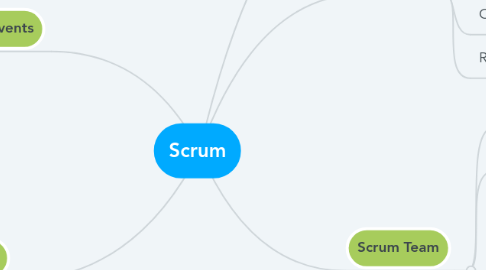
1. Scrum Events
1.1. Sprint Planning
1.2. Daily Scrum
1.3. Sprint Review
1.4. Sprint Retrospective
2. Artifacts
2.1. Product Backlog
2.2. Sprint Backlog
2.3. Increment
3. Definition
4. Values
4.1. Commitment
4.2. Courage
4.3. Focus
4.4. Openness
4.5. Respect
5. Scrum Team
5.1. Product Owner
5.1.1. Responsible for to maximizing the value of the product and the work of the Development Team
5.1.2. Sole person responsible for managing the Product Backlog.
5.1.3. Product Backlog management includes
5.1.3.1. Clearly expressing Product Backlog items
5.1.3.2. Ordering the items in the Product Backlog to best achieve goals and missions
5.1.3.3. Optimizing the value of the work the Development Team performs
5.1.3.4. Ensuring that the Product Backlog is visible, transparent, and clear to all, and shows what the Scrum Team will work on next
5.1.3.5. Ensuring the Development Team understands items in the Product Backlog to the level needed
5.2. Development Team
5.2.1. Consists of professionals who do the work of delivering a potentially releasable Increment of “Done” product at the end of each Sprint
5.2.2. They are self-organizing. No one (not even the Scrum Master) tells the Development Team how to turn Product Backlog into Increments of potentially releasable functionality
5.2.3. Development Teams are cross-functional, with all the skills as a team necessary to create a product Increment
5.2.4. Scrum recognizes no titles for Development Team members other than Developer, regardless of the work being performed by the person; there are no exceptions to this rule
5.2.5. Scrum recognizes no sub-teams in the Development Team, regardless of domains that need to be addressed like testing or business analysis; there are no exceptions to this rule
5.2.6. Individual Development Team members may have specialized skills and areas of focus, but accountability belongs to the Development Team
5.3. Scrum Master
5.3.1. Responsible for ensuring Scrum is understood and enacted
5.3.2. Is a servant-leader for the Scrum Team
5.3.3. Service to the Product Owner
5.3.3.1. Finding techniques for effective Product Backlog management
5.3.3.2. Helping the Scrum Team understand the need for clear and concise Product Backlog items
5.3.3.3. Understanding product planning in an empirical environment
5.3.3.4. Ensuring the Product Owner knows how to arrange the Product Backlog to maximize value
5.3.3.5. Understanding and practicing agility
5.3.3.6. Facilitating Scrum events as requested or needed
5.3.4. Service to the Development Team
5.3.4.1. Coaching the Development Team in self-organization and cross-functionality
5.3.4.2. Helping the Development Team to create high-value products
5.3.4.3. Removing impediments to the Development Team’s progress
5.3.4.4. Facilitating Scrum events as requested or needed
5.3.4.5. Coaching the Development Team in organizational environments in which Scrum is not yet fully adopted and understood
5.3.5. Service to the Organization
5.3.5.1. Leading and coaching the organization in its Scrum adoption
5.3.5.2. Planning Scrum implementations within the organization
5.3.5.3. Helping employees and stakeholders understand and enact Scrum and empirical product development
5.3.5.4. Causing change that increases the productivity of the Scrum Team
5.3.5.5. Working with other Scrum Masters to increase the effectiveness of the application of Scrum in the organization
